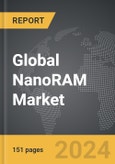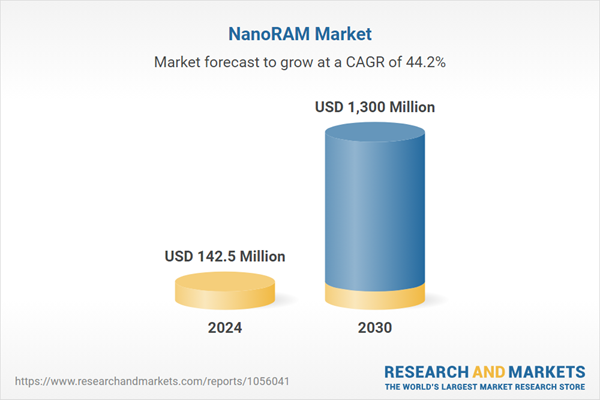The global market for NanoRAM was valued at US$142.5 Million in 2024 and is projected to reach US$1.3 Billion by 2030, growing at a CAGR of 44.2% from 2024 to 2030. This comprehensive report provides an in-depth analysis of market trends, drivers, and forecasts, helping you make informed business decisions. The report includes the most recent global tariff developments and how they impact the NanoRAM market.
Segments: Application (Enterprise Network & Systems, Embedded Systems, Other Applications).
Geographic Regions/Countries: World; USA; Canada; Japan; China; Europe; France; Germany; Italy; UK; Rest of Europe; Asia-Pacific; Rest of World.
The analysts continuously track trade developments worldwide, drawing insights from leading global economists and over 200 industry and policy institutions, including think tanks, trade organizations, and national economic advisory bodies. This intelligence is integrated into forecasting models to provide timely, data-driven analysis of emerging risks and opportunities.
Global NanoRAM Market - Key Trends & Drivers Summarized
What Is NanoRAM and How Does It Revolutionize Data Storage?
NanoRAM, or NRAM, is a type of nonvolatile random access memory that utilizes carbon nanotubes for storage. Unlike traditional RAM, which loses data when the power is turned off, NanoRAM retains data, combining the speed of RAM with the permanence of flash storage. The structure of NanoRAM is based on the unique properties of carbon nanotubes, which are extremely efficient at conducting electricity and heat. This nanotechnology-based approach allows for a denser, faster, and more energy-efficient memory solution. NanoRAM's potential for high-density data storage and its ability to withstand extreme environmental conditions without degrading its performance make it an ideal candidate for use in a wide range of electronics, from consumer mobile devices to enterprise servers and even applications in aerospace and military.How Is NanoRAM Superior to Other Memory Technologies?
NanoRAM boasts several distinct advantages over conventional memory technologies like DRAM and flash memory. One of the most significant benefits is its speed; NanoRAM can theoretically operate at speeds comparable to DRAM, significantly faster than traditional nonvolatile memories such as NAND flash. Additionally, it consumes less power, which not only extends the battery life of mobile devices but also reduces the energy costs in large-scale data centers. Durability is another area where NanoRAM excels; it can endure millions of write-read cycles without degradation, far surpassing the endurance of flash memory. These characteristics position NanoRAM as a transformative technology in the memory storage sector, potentially bridging the gap between volatile and nonvolatile memory with its dual benefits of speed and persistence.What Applications Are Expected to Drive NanoRAM Adoption?
The unique attributes of NanoRAM suggest its suitability for a broad array of applications. In consumer electronics, it could significantly enhance the performance and reliability of smartphones, tablets, and laptops. In the automotive sector, NanoRAM's robustness and quick access times make it ideal for use in advanced driver-assistance systems (ADAS) and autonomous vehicles, where quick data retrieval and storage can be critical for safety and performance. Additionally, NanoRAM is expected to find considerable utility in enterprise data storage solutions, offering faster access times and reduced power consumption for data centers. Moreover, its ability to operate reliably in harsh environmental conditions makes it an excellent choice for military and aerospace applications, where traditional memory solutions may fail.What Drives the Growth in the NanoRAM Market?
The growth in the NanoRAM market is driven by several factors, including the increasing demand for faster and more energy-efficient memory solutions across various sectors. As the volume of data generated by devices and enterprise systems continues to grow exponentially, the need for advanced memory technologies that can provide quick access and durability while reducing energy costs becomes crucial. Additionally, the expanding markets of IoT, AI, and big data analytics, where massive data processing and storage are required, significantly contribute to the demand for NanoRAM. The shift towards smart, connected devices and the proliferation of edge computing also necessitate the development of memory solutions that can handle large volumes of data efficiently and reliably. Consumer expectations for higher performance and longer battery life in mobile and portable devices further fuel the advancement and adoption of NanoRAM technology. These market dynamics, combined with ongoing innovations and improvements in nanotechnology and material science, ensure robust growth prospects for the NanoRAM market.Report Scope
The report analyzes the NanoRAM market, presented in terms of units. The analysis covers the key segments and geographic regions outlined below.Segments: Application (Enterprise Network & Systems, Embedded Systems, Other Applications).
Geographic Regions/Countries: World; USA; Canada; Japan; China; Europe; France; Germany; Italy; UK; Rest of Europe; Asia-Pacific; Rest of World.
Key Insights:
- Market Growth: Understand the significant growth trajectory of the Enterprise Network & Systems segment, which is expected to reach US$858.4 Million by 2030 with a CAGR of a 41.3%. The Embedded Systems segment is also set to grow at 53.3% CAGR over the analysis period.
- Regional Analysis: Gain insights into the U.S. market, valued at $51.8 Million in 2024, and China, forecasted to grow at an impressive 51.8% CAGR to reach $351.4 Million by 2030. Discover growth trends in other key regions, including Japan, Canada, Germany, and the Asia-Pacific.
Why You Should Buy This Report:
- Detailed Market Analysis: Access a thorough analysis of the Global NanoRAM Market, covering all major geographic regions and market segments.
- Competitive Insights: Get an overview of the competitive landscape, including the market presence of major players across different geographies.
- Future Trends and Drivers: Understand the key trends and drivers shaping the future of the Global NanoRAM Market.
- Actionable Insights: Benefit from actionable insights that can help you identify new revenue opportunities and make strategic business decisions.
Key Questions Answered:
- How is the Global NanoRAM Market expected to evolve by 2030?
- What are the main drivers and restraints affecting the market?
- Which market segments will grow the most over the forecast period?
- How will market shares for different regions and segments change by 2030?
- Who are the leading players in the market, and what are their prospects?
Report Features:
- Comprehensive Market Data: Independent analysis of annual sales and market forecasts in US$ Million from 2024 to 2030.
- In-Depth Regional Analysis: Detailed insights into key markets, including the U.S., China, Japan, Canada, Europe, Asia-Pacific, Latin America, Middle East, and Africa.
- Company Profiles: Coverage of players such as IBM Corporation, Samsung Group, Fujitsu Ltd., Intel Corporation, Hitachi Ltd. and more.
- Complimentary Updates: Receive free report updates for one year to keep you informed of the latest market developments.
Some of the 20 companies featured in this NanoRAM market report include:
- IBM Corporation
- Samsung Group
- Fujitsu Ltd.
- Intel Corporation
- Hitachi Ltd.
- Honeywell International, Inc.
- Infineon Technologies AG
- Cypress Semiconductor Corporation
- Micron Technology, Inc.
- Advanced Micro Devices, Inc.
- Nantero, Inc.
- NVE Corporation
- Everspin Technologies Inc.
- B&W Tek, Inc.
- Canon ANELVA Corporation
Tariff Impact Analysis: Key Insights for 2025
Global tariff negotiations across 180+ countries are reshaping supply chains, costs, and competitiveness. This report reflects the latest developments as of April 2025 and incorporates forward-looking insights into the market outlook.The analysts continuously track trade developments worldwide, drawing insights from leading global economists and over 200 industry and policy institutions, including think tanks, trade organizations, and national economic advisory bodies. This intelligence is integrated into forecasting models to provide timely, data-driven analysis of emerging risks and opportunities.
What’s Included in This Edition:
- Tariff-adjusted market forecasts by region and segment
- Analysis of cost and supply chain implications by sourcing and trade exposure
- Strategic insights into geographic shifts
Buyers receive a free July 2025 update with:
- Finalized tariff impacts and new trade agreement effects
- Updated projections reflecting global sourcing and cost shifts
- Expanded country-specific coverage across the industry
Table of Contents
I. METHODOLOGYII. EXECUTIVE SUMMARY2. FOCUS ON SELECT PLAYERSIII. MARKET ANALYSISIV. COMPETITION
1. MARKET OVERVIEW
3. MARKET TRENDS & DRIVERS
4. GLOBAL MARKET PERSPECTIVE
UNITED STATES
CANADA
JAPAN
CHINA
EUROPE
FRANCE
GERMANY
ITALY
UNITED KINGDOM
REST OF EUROPE
ASIA-PACIFIC
REST OF WORLD
Companies Mentioned (Partial List)
A selection of companies mentioned in this report includes, but is not limited to:
- IBM Corporation
- Samsung Group
- Fujitsu Ltd.
- Intel Corporation
- Hitachi Ltd.
- Honeywell International, Inc.
- Infineon Technologies AG
- Cypress Semiconductor Corporation
- Micron Technology, Inc.
- Advanced Micro Devices, Inc.
- Nantero, Inc.
- NVE Corporation
- Everspin Technologies Inc.
- B&W Tek, Inc.
- Canon ANELVA Corporation
Table Information
| Report Attribute | Details |
|---|---|
| No. of Pages | 151 |
| Published | April 2025 |
| Forecast Period | 2024 - 2030 |
| Estimated Market Value ( USD | $ 142.5 Million |
| Forecasted Market Value ( USD | $ 1300 Million |
| Compound Annual Growth Rate | 44.2% |
| Regions Covered | Global |









